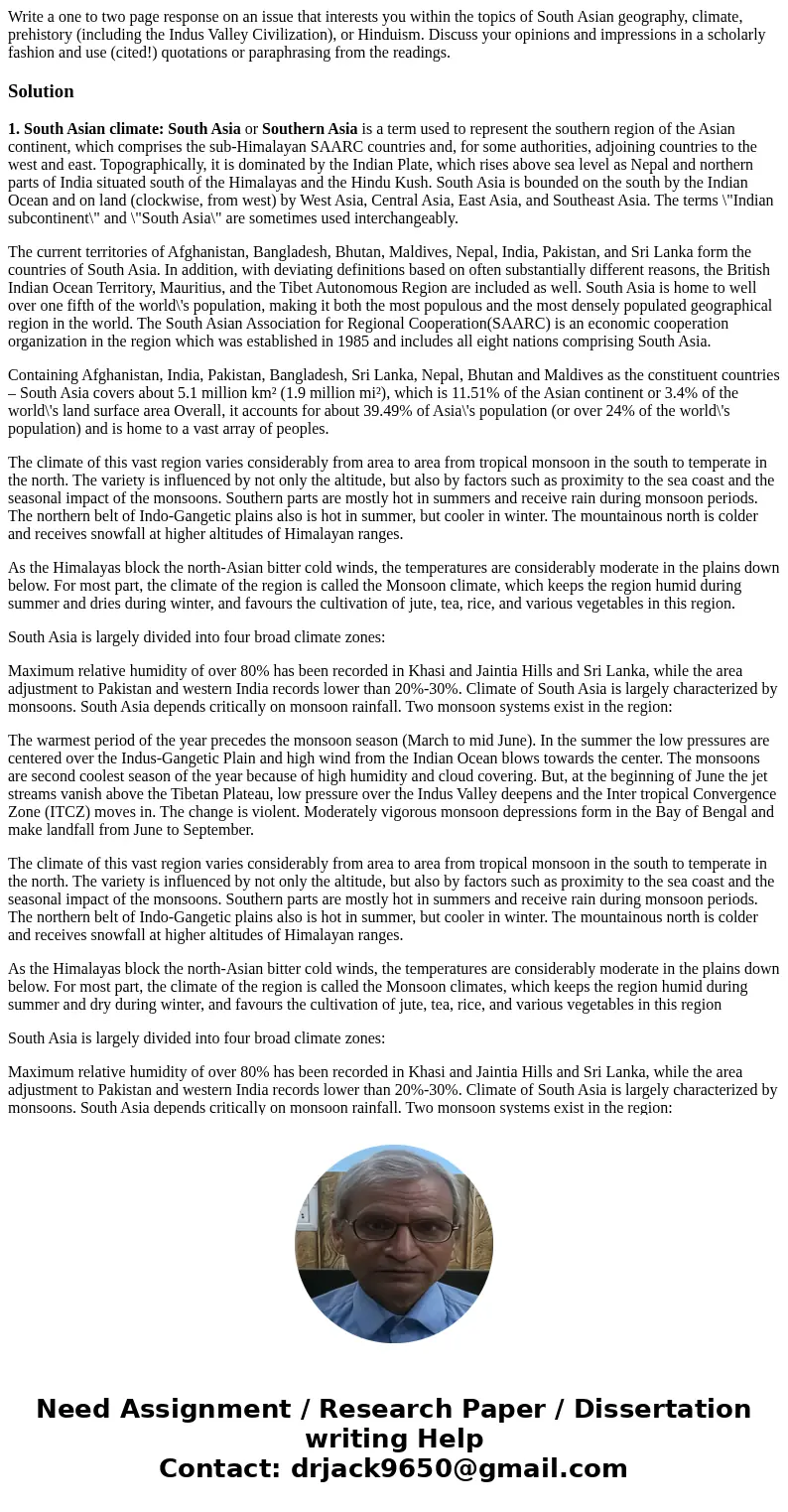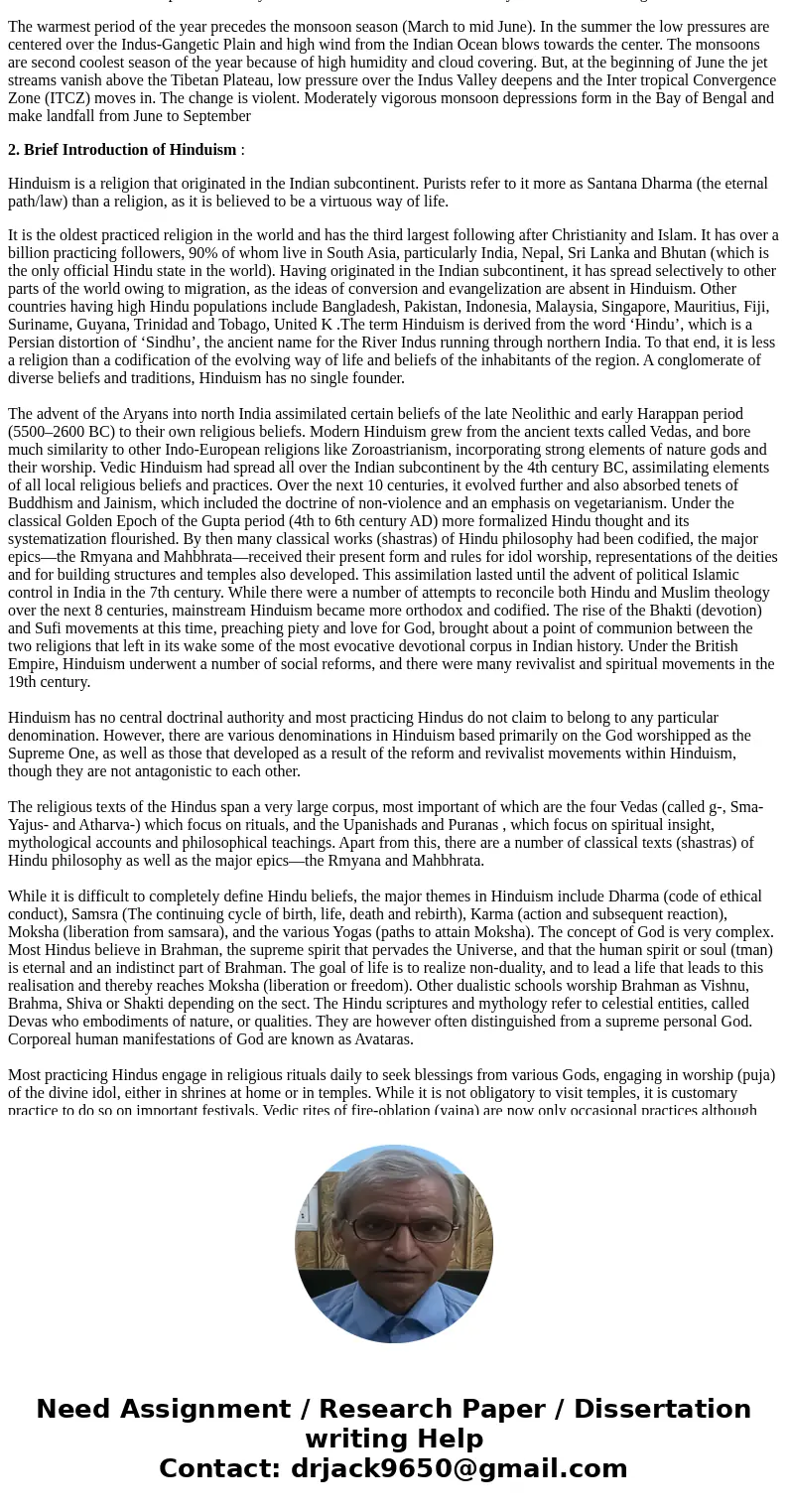Write a one to two page response on an issue that interests
Write a one to two page response on an issue that interests you within the topics of South Asian geography, climate, prehistory (including the Indus Valley Civilization), or Hinduism. Discuss your opinions and impressions in a scholarly fashion and use (cited!) quotations or paraphrasing from the readings.
Solution
1. South Asian climate: South Asia or Southern Asia is a term used to represent the southern region of the Asian continent, which comprises the sub-Himalayan SAARC countries and, for some authorities, adjoining countries to the west and east. Topographically, it is dominated by the Indian Plate, which rises above sea level as Nepal and northern parts of India situated south of the Himalayas and the Hindu Kush. South Asia is bounded on the south by the Indian Ocean and on land (clockwise, from west) by West Asia, Central Asia, East Asia, and Southeast Asia. The terms \"Indian subcontinent\" and \"South Asia\" are sometimes used interchangeably.
The current territories of Afghanistan, Bangladesh, Bhutan, Maldives, Nepal, India, Pakistan, and Sri Lanka form the countries of South Asia. In addition, with deviating definitions based on often substantially different reasons, the British Indian Ocean Territory, Mauritius, and the Tibet Autonomous Region are included as well. South Asia is home to well over one fifth of the world\'s population, making it both the most populous and the most densely populated geographical region in the world. The South Asian Association for Regional Cooperation(SAARC) is an economic cooperation organization in the region which was established in 1985 and includes all eight nations comprising South Asia.
Containing Afghanistan, India, Pakistan, Bangladesh, Sri Lanka, Nepal, Bhutan and Maldives as the constituent countries – South Asia covers about 5.1 million km² (1.9 million mi²), which is 11.51% of the Asian continent or 3.4% of the world\'s land surface area Overall, it accounts for about 39.49% of Asia\'s population (or over 24% of the world\'s population) and is home to a vast array of peoples.
The climate of this vast region varies considerably from area to area from tropical monsoon in the south to temperate in the north. The variety is influenced by not only the altitude, but also by factors such as proximity to the sea coast and the seasonal impact of the monsoons. Southern parts are mostly hot in summers and receive rain during monsoon periods. The northern belt of Indo-Gangetic plains also is hot in summer, but cooler in winter. The mountainous north is colder and receives snowfall at higher altitudes of Himalayan ranges.
As the Himalayas block the north-Asian bitter cold winds, the temperatures are considerably moderate in the plains down below. For most part, the climate of the region is called the Monsoon climate, which keeps the region humid during summer and dries during winter, and favours the cultivation of jute, tea, rice, and various vegetables in this region.
South Asia is largely divided into four broad climate zones:
Maximum relative humidity of over 80% has been recorded in Khasi and Jaintia Hills and Sri Lanka, while the area adjustment to Pakistan and western India records lower than 20%-30%. Climate of South Asia is largely characterized by monsoons. South Asia depends critically on monsoon rainfall. Two monsoon systems exist in the region:
The warmest period of the year precedes the monsoon season (March to mid June). In the summer the low pressures are centered over the Indus-Gangetic Plain and high wind from the Indian Ocean blows towards the center. The monsoons are second coolest season of the year because of high humidity and cloud covering. But, at the beginning of June the jet streams vanish above the Tibetan Plateau, low pressure over the Indus Valley deepens and the Inter tropical Convergence Zone (ITCZ) moves in. The change is violent. Moderately vigorous monsoon depressions form in the Bay of Bengal and make landfall from June to September.
The climate of this vast region varies considerably from area to area from tropical monsoon in the south to temperate in the north. The variety is influenced by not only the altitude, but also by factors such as proximity to the sea coast and the seasonal impact of the monsoons. Southern parts are mostly hot in summers and receive rain during monsoon periods. The northern belt of Indo-Gangetic plains also is hot in summer, but cooler in winter. The mountainous north is colder and receives snowfall at higher altitudes of Himalayan ranges.
As the Himalayas block the north-Asian bitter cold winds, the temperatures are considerably moderate in the plains down below. For most part, the climate of the region is called the Monsoon climates, which keeps the region humid during summer and dry during winter, and favours the cultivation of jute, tea, rice, and various vegetables in this region
South Asia is largely divided into four broad climate zones:
Maximum relative humidity of over 80% has been recorded in Khasi and Jaintia Hills and Sri Lanka, while the area adjustment to Pakistan and western India records lower than 20%-30%. Climate of South Asia is largely characterized by monsoons. South Asia depends critically on monsoon rainfall. Two monsoon systems exist in the region:
The warmest period of the year precedes the monsoon season (March to mid June). In the summer the low pressures are centered over the Indus-Gangetic Plain and high wind from the Indian Ocean blows towards the center. The monsoons are second coolest season of the year because of high humidity and cloud covering. But, at the beginning of June the jet streams vanish above the Tibetan Plateau, low pressure over the Indus Valley deepens and the Inter tropical Convergence Zone (ITCZ) moves in. The change is violent. Moderately vigorous monsoon depressions form in the Bay of Bengal and make landfall from June to September
2. Brief Introduction of Hinduism :
Hinduism is a religion that originated in the Indian subcontinent. Purists refer to it more as Santana Dharma (the eternal path/law) than a religion, as it is believed to be a virtuous way of life.
It is the oldest practiced religion in the world and has the third largest following after Christianity and Islam. It has over a billion practicing followers, 90% of whom live in South Asia, particularly India, Nepal, Sri Lanka and Bhutan (which is the only official Hindu state in the world). Having originated in the Indian subcontinent, it has spread selectively to other parts of the world owing to migration, as the ideas of conversion and evangelization are absent in Hinduism. Other countries having high Hindu populations include Bangladesh, Pakistan, Indonesia, Malaysia, Singapore, Mauritius, Fiji, Suriname, Guyana, Trinidad and Tobago, United K .The term Hinduism is derived from the word ‘Hindu’, which is a Persian distortion of ‘Sindhu’, the ancient name for the River Indus running through northern India. To that end, it is less a religion than a codification of the evolving way of life and beliefs of the inhabitants of the region. A conglomerate of diverse beliefs and traditions, Hinduism has no single founder.
The advent of the Aryans into north India assimilated certain beliefs of the late Neolithic and early Harappan period (5500–2600 BC) to their own religious beliefs. Modern Hinduism grew from the ancient texts called Vedas, and bore much similarity to other Indo-European religions like Zoroastrianism, incorporating strong elements of nature gods and their worship. Vedic Hinduism had spread all over the Indian subcontinent by the 4th century BC, assimilating elements of all local religious beliefs and practices. Over the next 10 centuries, it evolved further and also absorbed tenets of Buddhism and Jainism, which included the doctrine of non-violence and an emphasis on vegetarianism. Under the classical Golden Epoch of the Gupta period (4th to 6th century AD) more formalized Hindu thought and its systematization flourished. By then many classical works (shastras) of Hindu philosophy had been codified, the major epics—the Rmyana and Mahbhrata—received their present form and rules for idol worship, representations of the deities and for building structures and temples also developed. This assimilation lasted until the advent of political Islamic control in India in the 7th century. While there were a number of attempts to reconcile both Hindu and Muslim theology over the next 8 centuries, mainstream Hinduism became more orthodox and codified. The rise of the Bhakti (devotion) and Sufi movements at this time, preaching piety and love for God, brought about a point of communion between the two religions that left in its wake some of the most evocative devotional corpus in Indian history. Under the British Empire, Hinduism underwent a number of social reforms, and there were many revivalist and spiritual movements in the 19th century.
Hinduism has no central doctrinal authority and most practicing Hindus do not claim to belong to any particular denomination. However, there are various denominations in Hinduism based primarily on the God worshipped as the Supreme One, as well as those that developed as a result of the reform and revivalist movements within Hinduism, though they are not antagonistic to each other.
The religious texts of the Hindus span a very large corpus, most important of which are the four Vedas (called g-, Sma- Yajus- and Atharva-) which focus on rituals, and the Upanishads and Puranas , which focus on spiritual insight, mythological accounts and philosophical teachings. Apart from this, there are a number of classical texts (shastras) of Hindu philosophy as well as the major epics—the Rmyana and Mahbhrata.
While it is difficult to completely define Hindu beliefs, the major themes in Hinduism include Dharma (code of ethical conduct), Samsra (The continuing cycle of birth, life, death and rebirth), Karma (action and subsequent reaction), Moksha (liberation from samsara), and the various Yogas (paths to attain Moksha). The concept of God is very complex. Most Hindus believe in Brahman, the supreme spirit that pervades the Universe, and that the human spirit or soul (tman) is eternal and an indistinct part of Brahman. The goal of life is to realize non-duality, and to lead a life that leads to this realisation and thereby reaches Moksha (liberation or freedom). Other dualistic schools worship Brahman as Vishnu, Brahma, Shiva or Shakti depending on the sect. The Hindu scriptures and mythology refer to celestial entities, called Devas who embodiments of nature, or qualities. They are however often distinguished from a supreme personal God. Corporeal human manifestations of God are known as Avataras.
Most practicing Hindus engage in religious rituals daily to seek blessings from various Gods, engaging in worship (puja) of the divine idol, either in shrines at home or in temples. While it is not obligatory to visit temples, it is customary practice to do so on important festivals. Vedic rites of fire-oblation (yajna) are now only occasional practices although they are highly revered in theory. In Hindu wedding and burial ceremonies, however, the yajña and chanting of Vedic mantras are still the norm.
Occasions like birth, marriage, and death involve what are often elaborate sets of religious customs. On death, cremation is considered obligatory and is typically performed by wrapping the corpse in cloth and burning it on a pyre.
Pilgrimage is not mandatory in Hinduism, though Hindus have several holy cities and temple cities. Important centers of Hindu pilgrimage include Allahabad, Varanasi, Hardwar, Tirumala - Tirupati and Katra, home to the Vaishno Devi temple, as well as sets of pilgrim centres linked together with theology. Hinduism has many festivals throughout the year, which are assigned by the Hindu calendar. Hindu festivals usually have their grounding in mythology, and some widely observed Hindu festivals include Holi, Dussera and Diwali.
However, the most important impact of Hinduism has been on the evolution of society. According to traditional Hindu belief, there are four stages of a human life (shramas), which are the stage as a student (spent in celibate, controlled, contemplation under a teacher), householder, retirement (gradual detachment from the material world) and finally asceticism to find Moksha. Society was classified into four classes, called Varnas – teachers and priests (Brahmins), warriors, nobles, and kings (Kshatriyas), farmers, merchants, and businessmen (Vaishyas) and the servants and labourers (Shudras). These classes slowly evolved to extremely rigid castes and sub-castes, setting in place an exceedingly oppressive hierarchy over the course of history. Most reform movements in the 19th and early 20th century addressed a number of these issues, and modern Hinduism is far more liberal, though the principles of caste and class still tend to become important in issues of marriage and social norms and politics. United Kingdom and Canada.



 Homework Sourse
Homework Sourse